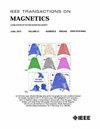Effects of Fe, Cu, and Zr Substitutions on Microstructure of SmCo/Fe(Co) Nanocomposite Magnets
IF 2.1
3区 工程技术
Q3 ENGINEERING, ELECTRICAL & ELECTRONIC
引用次数: 0
Abstract
The substitution of alloy elements is an effective method to tailor the phase composition and microstructure of nanocomposite magnets. Here, a good microstructure, i.e., high soft phase content (~28.5 wt.%), small soft phase grain size (~10 nm), and uniform distribution of soft magnetic phase grains, was successfully realized in a SmCo/Fe(Co) nanocomposite magnet through the simultaneous substitution of Fe, Cu, and Zr alloy elements. The influences of alloy element substitutions on phase composition and microstructure of SmCo nanocomposite magnets have been studied. The substitution of Fe element increases the content of soft magnetic phase. The substitution of Cu element promotes the crystallization degree of hard magnetic phase at low temperature. The substitution of Zr element reduces the grain size of the soft magnetic phase Fe(Co). The simultaneous substitution of the three elements stabilizes the existence of SmCo3 phase, which greatly improves theFe、Cu和Zr取代对SmCo/Fe(Co)纳米复合磁体微观结构的影响
合金元素的替代是调整纳米复合磁体相组成和微观结构的有效方法。在SmCo/Fe(Co)纳米复合磁体中,通过同时替换Fe、Cu和Zr合金元素,成功地获得了高软相含量(~28.5 wt.%)、小软相晶粒尺寸(~10 nm)和均匀软磁相晶粒分布的良好组织。研究了合金元素取代对SmCo纳米复合磁体相组成和显微组织的影响。铁元素的取代增加了软磁相的含量。Cu元素的取代提高了硬磁相在低温下的结晶程度。Zr元素的取代减小了软磁相Fe(Co)的晶粒尺寸。三种元素的同时取代稳定了SmCo3相的存在,大大提高了样品的$H_{\ mathm {c}}$。当Fe、Cu和Zr的含量分别为14.4%和3.0%时,磁能积在580℃时达到最佳。
本文章由计算机程序翻译,如有差异,请以英文原文为准。
求助全文
约1分钟内获得全文
求助全文
来源期刊

IEEE Transactions on Magnetics
工程技术-工程:电子与电气
CiteScore
4.00
自引率
14.30%
发文量
565
审稿时长
4.1 months
期刊介绍:
Science and technology related to the basic physics and engineering of magnetism, magnetic materials, applied magnetics, magnetic devices, and magnetic data storage. The IEEE Transactions on Magnetics publishes scholarly articles of archival value as well as tutorial expositions and critical reviews of classical subjects and topics of current interest.
 求助内容:
求助内容: 应助结果提醒方式:
应助结果提醒方式:


